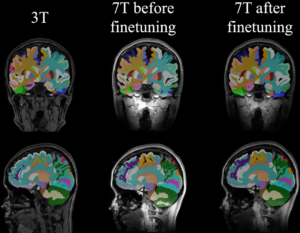Deep whole brain segmentation of 7T structural MRI
Karthik Ramadass, Xin Yu, Leon Y. Cai, Yucheng Tang, Shunxing Bao, Cailey Kerley, Micah D’Archangel, Laura A Barquero, Allen T. Newton, Isabel Gauthier, Rankin Williams McGugin, Benoit M. Dawant, Laurie E. Cutting, Yuankai Huo, Bennett A. Landman SPIE Medical Imaging 2023
Abstract
7T magnetic resonance imaging (MRI) has the potential to drive our understanding of human brain function through new contrast and enhanced resolution. Whole brain segmentation is a key neuroimaging technique that allows for region–by–region analysis of the brain. Segmentation is also an important preliminary step that provides spatial and volumetric information for running other neuroimaging pipelines. Spatially localized atlas network tiles (SLANT) is a popular 3D convolutional neural network (CNN) tool that breaks the whole brain segmentation task into localized sub–tasks. Each sub–task involves a specific spatial location handled by an independent 3D convolutional network to provide high resolution whole brain segmentation results. SLANT has been widely used to generate whole brain segmentations from structural scans acquired on 3T MRI. However, the use of SLANT for whole brain segmentation from structural 7T MRI scans has not been successful due to the inhomogeneous image contrast usually seen across the brain in 7T MRI. For instance, we demonstrate the mean percent difference of SLANT label volumes between a 3T scan–rescan is approximately 1.73%, whereas its 3T–7T scan–rescan counterpart has higher differences around 15.13%. Our approach to address this problem is to register the whole brain segmentation performed on 3T MRI to 7T MRI and use this information to finetune SLANT for structural 7T MRI. With the finetuned SLANT pipeline, we observe a lower mean relative difference in the label volumes of ~8.43% acquired from structural 7T MRI data. Dice similarity coefficient between SLANT segmentation on the 3T MRI scan and the after finetuning SLANT segmentation on the 7T MRI increased from 0.79 to 0.83 with p<0.01. These results suggest finetuning of SLANT is a viable solution for improving whole brain segmentation on high resolution 7T structural imaging.

